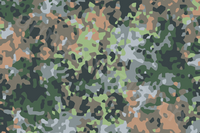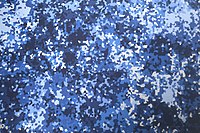
The Desert Battle Dress Uniform (DBDU) is a U.S. arid-environment camouflage battle uniform that was used by the United States Armed Forces from the early 1980s to the early to mid 1990s, most notably during the Persian Gulf War. Although the U.S. military has long since abandoned the pattern, it is still in widespread use by militaries across the world as of the early 2020s.

Flecktarn is a family of three-, four-, five- or six-color disruptive camouflage patterns, the most common being the five-color pattern, consisting of dark green, grey-green, red brown, and black over a light green or tan base depending on the manufacturer. The original German five-color pattern was designed for use in European temperate woodland terrain. A three-color variation called Tropentarn is intended for arid and desert conditions; the German Bundeswehr wore it in Afghanistan.
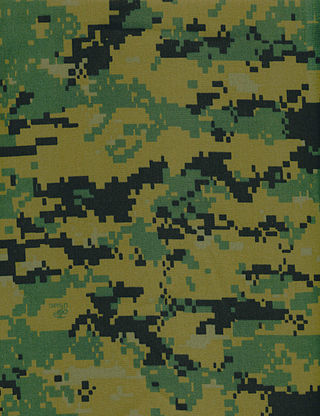
MARPAT is a multi-scale camouflage pattern in use with the United States Marine Corps, designed in 2001 and introduced from late 2002 to early 2005 with the Marine Corps Combat Utility Uniform (MCCUU), which replaced the Camouflage Utility Uniform. Its design and concept are based on the Canadian CADPAT pattern. The pattern is formed of small rectangular pixels of color. In theory, it is a far more effective camouflage than standard uniform patterns because it mimics the dappled textures and rough boundaries found in natural settings. It is also known as the "digital pattern" or "digi-cammies" because of its micropattern (pixels) rather than the old macropattern.

The Royal Netherlands Army is the land branch of the Netherlands Armed Forces. Though the Royal Netherlands Army was raised on 9 January 1814, its origins date back to 1572, when the Staatse Leger was raised making the Dutch standing army one of the oldest in the world. It fought in the Napoleonic Wars, World War II, the Indonesian War of Independence and the Korean War, as well as served with NATO on the Cold War frontiers in West Germany from the 1950s to the 1990s.

The Army Combat Uniform (ACU) is the current combat uniform worn by the United States Army, U.S. Air Force, and U.S. Space Force. Within U.S. Air Force and U.S. Space Force, it is referred to as the OCP Uniform, rather than the Army Combat Uniform.

A combat uniform, also called field uniform, battledress or military fatigues, is a casual type of uniform used by military, police, fire and other public uniformed services for everyday fieldwork and combat duty purposes, as opposed to dress uniforms worn in functions and parades. It generally consists of a jacket, trousers and shirt or T-shirt, all cut to be looser and more comfortable than more formal uniforms. Design may depend on regiment or service branch, e.g. army, navy, air force, marines, etc. In the army branches, fabrics tend to come in camouflage, disruptive pattern or else green, brown or khaki monochrome, in order to approximate the background and make the soldier less visible in nature. In Western dress codes, field uniform is considered equivalent to civilian casual wear. As such, field uniform is considered less formal than service dress uniform, generally aimed at office or staff use, as well as mess dress uniform, and full dress uniform.
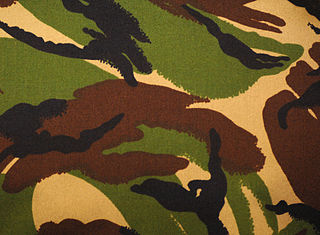
Disruptive Pattern Material (DPM) is the commonly used name of a camouflage pattern used by the British Armed Forces as well as many other armed forces worldwide, particularly in former British colonies.

MultiCam is a camouflage pattern designed for use in a wide range of environments and conditions which was specifically developed and is produced by American company Crye Precision. As a result of the pattern's effectiveness across disparate environments and regions, it has found extensive adoption globally. Variants of it, some unlicensed, are in use with armed forces worldwide, particularly with special operations units.

The Desert Camouflage Uniform (DCU) is an arid-environment camouflage uniform that was used by the United States Armed Forces from the mid-1990s to the early 2010s. In terms of pattern and textile cut, it is identical to the U.S. military's Battle Dress Uniform (BDU) uniform, but features a three-color desert camouflage pattern of dark brown, pale olive green, and beige, as opposed to the four-color woodland pattern of the BDU. It replaced the previous Desert Battle Dress Uniform (DBDU) which featured a six-color "chocolate chip" pattern of beige, pale olive green, two tones of brown, and black and white rock spots. Although completely phased out of frontline use in the U.S. Armed Forces, some pieces and equipment printed in the DCU camouflage pattern are used in limited numbers such as MOPP suits and/or vests.

The Desert Night Camouflage pattern is a two-color grid camouflage pattern used by the United States military during the Gulf War. It was designed to aid soldiers in concealment from Soviet-based night vision devices (NVDs). The pattern is now considered obsolete due to the increase in capability of foreign night vision devices.
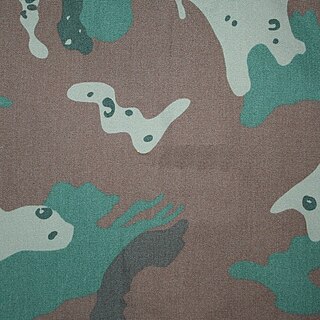
Soldier 2000 is a military camouflage pattern developed by the Council for Scientific and Industrial Research and is in use with the South African National Defence Force (SANDF). It is designed to be effective in all terrains and seasons encountered across South Africa.

The Universal Camouflage Pattern (UCP) is a digital military camouflage pattern formerly used by the United States Army in their Army Combat Uniform. Technicians at Natick Soldier Systems Center attempted to devise a uniform pattern that would mask the wearer in all seasonal environments. Laboratory and field tests from 2003 to 2004 showed a pattern named "All-Over-Brush" to provide the best concealment of the patterns tested. All-Over-Brush was selected as the winner over ten other patterns. The disadvantage of an all-in-one pattern is that it is a combination of what is effective in many different environments and is less effective in a particular environment when compared to a specialized coloration designed specifically for that environment. The winning All-Over-Brush pattern was not used as the final UCP. Instead, U.S. Army leadership utilized pixellated images taken from Canadian CADPAT and US Marine Corps MARPAT, then recolored them based on three universal colors developed in the Army's 2002-2004 tests, to be called the UCP. While the pixelated pattern of the UCP is similar to the MARPAT and CADPAT camouflage patterns used by the United States Marine Corps and the Canadian Armed Forces, its coloration differs significantly. The final UCP was then adopted without field testing against other patterns.

The U.S. Woodland is a camouflage pattern that was used as the default camouflage pattern issued to the United States Armed Forces from 1981, with the issue of the Battle Dress Uniform, until its replacement in the mid to late 2000s. It is a four color, high contrast disruptive pattern with irregular markings in green, brown, sand and black. It is also known unofficially by its colloquial moniker of "M81" after the Battle Dress Uniform it was first used on, though this term was not officially used by the U.S. military.
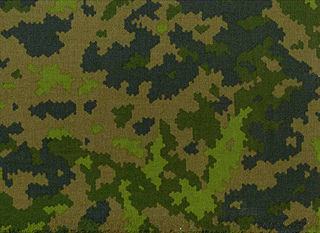
The M05, sometimes known as the M05 Terrain Pattern, is a family of military camouflage patterns used by the Finnish Defence Forces on uniforms and other equipment. The pattern is licensed by the Finnish Defence Forces and became available to the public on 26 September 2016.

The Camouflage Central-Europe is the standard camouflage pattern of the French Armed Forces.

Canadian Disruptive Pattern is the computer-generated digital camouflage pattern developed for use by the Canadian Armed Forces. Four operational variations of CADPAT have been used by the Canadian Armed Forces: a temperate woodland pattern, an arid regions pattern, a winter operations pattern, and a multi-terrain pattern.

Frog Skin, also known as Duck Hunter, is a battledress camouflage pattern with mottle and disruptive coloration to blend into the environment similar to a frog's crypsis skin.

Xingkong, is a military camouflage pattern adopted in 2019 by all branches of the People's Liberation Army (PLA) of the People's Republic of China (PRC). Introduced in 2019, the Xingkong pattern replaced the Type 07 camouflage on the Type 07 service uniforms used by regular units. The new uniform and Xingkong camouflage were first seen in late September 2019 before the celebration ceremony for the 70th anniversary of the People's Republic of China.

EMR ; or Universal Camouflage Colourway in English, is a military camouflage pattern in use by the Russian Armed Forces. It is sometimes referred to by the unofficial nicknames RUSPAT, Tetris, Tsifra and Digital Flora. EMR camouflage is the standard camouflage pattern of the Russian Military's VKBO All-Season Uniform.


